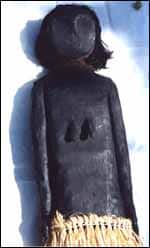
“I’ve been promised Rameses the Second, and I’m hoping that’ll come in soon.” Stephen Macko enthuses. It’s a pretty impressive catch for any researcher, but Macko won’t be getting the whole Pharoah, just a milligram or so of hair. That, however, is more than enough for Macko. He can learn a lot from it. “You are what you eat,” he explains. “The isotopes of your diet gets incorporated into your body, and eventually comes out in your hair.”

Macko, a environmental science professor from the University of Virginia, and his team have succeeded in doing amazing things with ancient hair. By putting hairs from over a hundred and fifty well-preserved mummies thousands of years old into a mass spectrometer, he can measure the isotopes of common elements like carbon, nitrogen and sulphur, and get a very good idea what the ancients did and didn’t eat.
Macko analyzed preserved hair from mummies from the Middle Kingdom period of ancient Egypt, as well as comparatively modern (1000 years old) Egyptian Coptic mummies. He also looked at the hair of mummies from a few different ancient Chinchorro communities in Chile. The star of Macko’s show is undoubtedly “Oetzi the Ice Man”, the Neolithic man who slipped into an ice crevasse in the Austrian-Italian Oetzaler Alps 5,300 years ago. His findings shed new light on intimate eating habits hither-to unknown. Even the most upper-class Middle Kingdom mummies, for instance, never ate as well as the run of the mill Coptic Egyptians that lived a few thousand years later. The latter enjoyed a diet wide enough to earn it Macko’s monicker, “the supermarket diet”.
By knowing what was on the menu, archaeologists can extrapolate how ancient people may have lived. For example, Macko’s team found that 75% to 90% of the diet of ancient coastal-dwelling Chinchorro people of Chile came from the sea. Agricultural groups living near the desert farther inland lived very differently, eating corn and other vegetables. One individual mummy from the inland group kept coming up as a lone marine eater. He had come from the coast, proving conclusively for the first time that there was communication between the two groups.
The biggest surprise was the diet of the Iceman of the Austrian Alps. Though he was found with a goatskin cloak and an unfinished bow and arrow, the lone traveler who perished 6,000 years ago had a strict vegetarian diet that included no milk or eggs. “It has been suggested that he was maybe a shaman of some sort,” speculates Macko. “His diet was not from hunting, even though he was wearing a goat skin. That may have been given to him as he visited a village.”
“It takes about six days for your breakfast to start showing up in your hair,” explains Macko. “When looking at hair, we’re looking at a snapshot of a diet. Hair grows about a centimeter a month, and so by taking a clipping across several hairs that are different distances from the scalp, we get more of a cross section of the diet.”
The organic matter of the hair is converted into gas which is fed into the mass spectrometer, which can detect the composition of the sample by measuring its mass. To his surprise he found that hair manages to preserve its structural integrity for thousands of years. “Our crazy idea was to look at something we thought might be well preserved. It turns out that if you find a piece of hair that’s 5,000 years old, it would look like something off the barbershop floor. Its chemistry is not going to be changed.”

For the last decade and a half, forensic archaeologists have looked at a connective protein called collagen found in bones. “Collagen doesn’t hang around too long. It dissolves in water. You can look at the mineral matrix in bone but that doesn’t change too much between individuals.” Besides being more well preserved, hair has other advantages. It’s easier to analyze than collagen. Instead of working with many of grams of bone, which can destroy a skeleton, hair requires only a little trim around the size of the head of a pin.
“That’s why we’ve had such good responses from [museums], says Macko, referring to his mummies. “I once asked for one of the teeth of the Ice Man when I thought I might pursue the collagen technique, and I was told I didn’t have a prayer.” A snippet of hair, it seems, posed no problem.
“I don’t know why we’re not up to our eyeballs in hair,” muses Macko about archaeology. Hair is made of an unusual type of protein called an alpha-keratin, also found in feathers and fingernails, which has a tightly-coiled alpha helix spiral structure. To break it down, organisms have to excrete an enzyme on the outside of their cells to attack the very rigid structure, and not many organisms besides some fungi and a few bacteria are capable of it. Hair stays resistant to any kind of decay.
Macko hopes to hone the technique by using his mass spectrometer to measure the exact essential amino acids present in the hair. Presently he’s able to ascertain the general food groups, such as fish, meat, grain, bean or shellfish. With less ambiguity about what foods were consumed, he hopes to be able to further deduce ancient behaviour. “Its coming,” he says confidently. “My laboratory is one of the few that has ever measured isotope signals of amino acids. We’re just having fun now.”